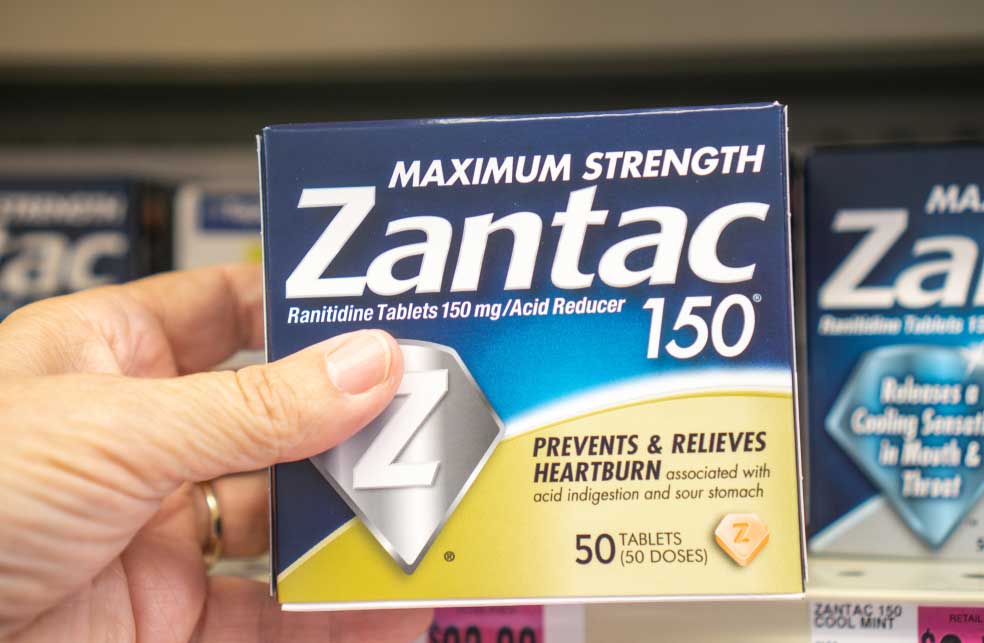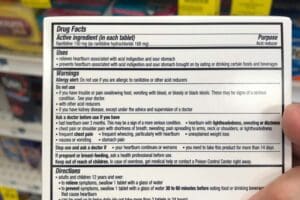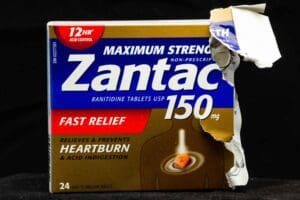Thanks to the advent of technology and advances in the health industry, various products are now available to help you improve and maintain your health. Certain medicines keep your body strong and reduce your risk of developing serious illnesses and diseases.
But how would you feel if one type of medication causes harm to your overall health? For example, what would you do if you found out the medicine you’ve been using for years is associated with cancer?
What is Zantac?
Ranitidine, popularly sold under the brand name Zantac, is a medication known to decrease the production of acid in the stomach. In 2020 alone, Zantac and other generic ranitidine formulas sold about 16 million pieces in the United States alone.
Originally, Zantac was an H2 antagonist used to treat ulcerated stomachs, GERD, stomach pain. Zantac was also prescribed by healthcare professionals to treat gastroesophageal reflux disease (GERD), ulcers, and other health conditions where the stomach secretes too much acid.
Aside from being sold in OTC tablets and capsules, ranitidine can also be purchased as a pediatric syrup. This was widely used to treat ulcers in children at least one year old.
Zantac and NDMA
To understand the link between Zantac and cancer, one must look into the ingredients of this medication. In a nutshell, Zantac might seem to benefit human health, but upon looking at its ingredients, you’ll understand why this medication has gained negative responses worldwide.
Zantac contains NDMA, an environmental contaminant classified under potential carcinogen. Small traces of NDMA are present in the environment — in the water, air, and soil. In addition, certain foods, such as sausage, cheese, bacon, and cured meats, also contain small amounts of NDMA.
NDMA is produced by chemical reactions to nitrates and nitrites present in many processed foods and tobacco smoke. In some cases, the contaminant can be found in some workplaces as a by-product of their manufacturing processes. NDMA is more common in rubber and tire manufacturers, pesticide manufacturing plants, and tanneries.
NDMA also forms as a result of the chlorination process of drinking water and wastewater. This is the reason why NDMA is common among many municipal chlorinated water supplies.
Does Zantac Cause Cancer?
The Food and Drug Administration classified NDMA as a “probably human carcinogen.” The classification was based on several studies done on animals, like mice and rats, exposed to extremely high levels of NDMA. These studies concluded that long-term and excessive exposure to NDMA could cause lung cancer and liver damage in animals.
The studies are still unclear whether exposure to NDMA directly causes cancer in humans. However, the Agency for Toxic Substances and Disease Registry confirmed that it’s reasonable for humans to expect higher risks of cancer after being exposed to NDMA for long periods.
What experts know about NDMA is that it can cause hepatoxicity or liver poisoning in humans. This health condition is life-threatening and can cause several symptoms, namely the yellowing of the eyeballs and skin (a condition also known as jaundice), abdominal swelling, and severe pain in the upper abdomen. Some also experience malaise due to hepatoxicity.
The results of animal studies showed that NDMA could stimulate the release of inflammatory cytokines after being metabolized by the liver. This can cause severe liver inflammation, which can eventually worsen into cirrhosis (or the scarring of the liver) and fibrosis.
Although the link between NDMA and cancer in humans isn’t clear, experts still believe that the long-term use of NDMA can increase a person’s cancer risk.
Types of Cancer-Associated with Zantac
Through the years, the following types of cancer have been associated with Zantac:
Bladder Cancer
The government of Ontario, Canada, has set nine nanograms as the safe limit for NDMA ingestion. This means that individuals exposed to this amount (or less) of NDMA aren’t at risk of any health hazards. However, a study showed that one 150 milligrams of ranitidine already contains more than 47,000 nanograms of NDMA.
Several studies were later published to support the link between NDMA and bladder cancer. A 2011 study created and published by the government of Ontario, Canada, stated that excessive amounts of NDMA can cause leukemia and cancer of the bladder. A landmark study in 2004 showed that people taking Zantac were at “heightened risk of balder cancer.”
Some of the common symptoms of bladder cancer include blood clots in the urine, pain during urination, and feeling the need to urinate several times during the night. Individuals diagnosed with bladder cancer also experience recurring lower back pain on one side of their bodies.
Colorectal Cancer
Aside from bladder cancer, Zantac has also been associated with colorectal cancer. This type of cancer is the third most diagnosed cancer globally, with almost two million people diagnosed in 2020.
Several studies were published to show the relation between NDMA exposure and the increased risk of colorectal cancer. For example, a 1999 study showed a positive association between the intake of NDMA and the risk of colorectal cancer. The study indicates that individuals who regularly consumed foods that contained this contaminant were at a higher risk of developing colorectal cancer. The researchers behind the study concluded that “our results show that NDMA can include colorectal cancer in humans.” This study ran for 24 years and involved 10,000 people.
A 2014 study looked into 1,700 patients to see the correlation of the intake of NDMA to colorectal cancer. Results showed that regular use of NDMA was associated with a higher risk of colorectal cancer. The more foods containing NDMA the patients are, the higher their risk of colorectal cancer.
The most recent study showing the connection of NDMA to colorectal cancer was published in 2019. Researchers investigated the connection between drinking water with high amounts of NDMA and the incidents of colorectal cancer in 15,000 women. The results indicated that exposure to the chemical increases a person’s risk of colorectal cancer.
Prostate Cancer
The association of Zantac to different types of cancer doesn’t end with bladder and colorectal cancers. Several studies were also published to link the medicine, specifically its NDMA content, to prostate cancer.
Prostate cancer is not one of the primary health conditions linked to Zantac use, but it was found that long-term use of NDMA can contribute to the development of this type of cancer.
A 2009 study showed that men who consumed more processed meats and red meats have a higher risk of developing cancer. After examining the data, researchers found NDMA causes the carcinogenic effect of these meats. This compound is produced when meats are cured.
Liver Cancer
Zantac has been associated with many types of cancer, and liver cancer is one of them. This was later supported by several studies that focused on establishing the connection between NDMA and liver cancer in humans.
A 2006 study concluded that NDMA causes tumors in various human organs, including the kidney, pancreas, lungs, and bladder. The study also mentioned that Zantac liver cancer risk is elevated because NDMA causes digestive tract cancers specifically — and the liver is part of the human digestive system.
Stomach or Gastric Cancer
Several animal studies have already displayed the toxic effects of NDMA after short- and medium-term exposures (ranging from 1 to 12 weeks). Most of the animals tested for the studies showed gastrointestinal bleeding and, eventually, symptoms of stomach or gastric cancer.
Although there were limited studies showing the connection between NDMA and stomach cancer in humans, two were conclusive. For example, a study published in the British Medical Journal (BMJ) in 2018 showed that individuals taking blood pressure medications with NDMA have an increased risk of stomach or gastric cancer.
Another human study involving 23,000 men and women aged from 40 to 79 showed that regular intake of NDMA significantly increased their risk of gastrointestinal cancer. This was eventually supported by another study published in 1999. The study involved observing 10,000 men and women for 24 years as they use NDMA every day. By the end of the study, 189 of them were diagnosed with gastrointestinal cancer.
Breast Cancer
Breast cancer is the most common type of cancer among women, affecting more than 13% of women in the United States. One in every three women is diagnosed with breast cancer in the United States annually.
A 2008 study showed a direct link between Zantac and breast cancer. The results of the study concluded that patients who took the drug every day had an increased risk of developing breast cancer by up to 240%, in contrast to individuals who don’t use ranitidine.
Other Types Of Health Conditions Linked To Zantac
Aside from different types of cancer, Zantac has been associated with various health conditions. Although there are still no studies to confirm the connection, many people were diagnosed with Primary Pulmonary Hypertension and Cohn’s diseases after long-term use of Zantac.
Primary Pulmonary Hypertension or PPH is a rare lung condition that triggers exceptionally high blood pressure. This health condition occurs when the blood vessels found in the lungs become too narrow that they start to raise the pressure in a person’s cardiovascular system above normal levels.
Cohn’s disease, on the other hand, is an inflammatory bowel disease that causes the digestive tract to become inflamed. This health condition can cause abdominal pain, weight loss, and severe diarrhea.
What Are The Damages Caused By Zantac-Associated Cancers?
Some people with cancer are prone to severe injury from Zantac. Cancer is the most damaging kind of illness, and each type inflicts a particular kind of harm and affects people’s lives in different ways. In a product liability case, cancer-diagnosed individuals may seek several damages from the use and the potential loss of earnings caused by Zantac.
Economic Damages
Even individuals with good health insurance may find themselves financially devastated after receiving treatment from Zantac. Frequently injuries cause financial damages, and they can also be considered a basis in personal injury lawsuits. Zantac cancer causes significant economic damage and hospital costs. Cancer treatments are notoriously expensive, which drains the money from those most prepared. Aside from initial medical expenses, recurring costs like medication refills or periodic medical treatments are sometimes even more expensive.
Non-Economic Damages
Most damages aren’t as easily measurable or easy to quantify as financial losses such as health insurance bills or stubs. There are numerous damages not directly causing money loss which are called non-economic damages or monetary damages. Zantac-induced cancer is often a serious and painful condition physically and emotionally. Despite the pain, the pain is equally as serious as those of Zantac cancer victims.
Were There Lawsuits Filed Against Zantac?
NDMA contaminating drug Zantac has been linked to cancer in many people in recent times. Several people who have filed suit against Zantac seek damages in connection with bladder, bowel, heart, and lung cancers alleged to have been caused by NDMA toxicity.
A lawsuit brought by Zantaco in California will begin in September as it prepares for the first trial. Judge Evelio Grillo announced a deadline to file a Ranitidine Products Case in California on October 10, 2022. In August 2021, the case was re-examined by the United States Supreme Court in New Orleans. Federal judge Rob Rosenberg ruled in favor of the defendants’ case. The case is pending at the hands of Justice Rosenberg.
Zantac also faces lawsuits from Pfizer, BP Healthcare LLP, and Sanofi. A federal judge has decided he cannot sue generic drug companies for their generic drug business.
Are You Eligible to File a Zantac Lawsuit?
To potentially qualify for a Zantac or ranitidine lawsuit, individuals must satisfy 3 criteria:
- Proven use of Zantac or other ranitidine products
- Cancer diagnosis
- Connection between cancer diagnosis and Zantac/ranitidine
If you or someone in your family developed cancer after taking Zantac or other ranitidine products, we can evaluate your claim and help you gather medical records and evidence to build a case.



